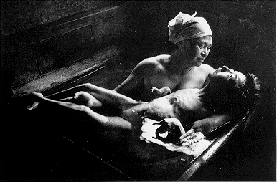|
Last week I had lunch with a good friend. He's a network television cameraman, who has spent much of the past two decades covering the wars and turmoil in Africa. He wanted to talk about a new experience that is troubling him. A friend of his, who is a hypnotist, had urged him to let her put him into a trance to show what hypnotism could do to relieve the pain of serious back damage caused by years of lugging a betacam around the world. She started the procedure by evoking the image of a boat, intending to instill a feeling of balance, of moving forward. But, under hypnosis, his mind went immediately to a long forgotten boat ride across a muddy Angolan river: "On the opposite bank panicked men, women and children are hurling themselves either into one of the two makeshift boats or straight into the waters, desperate to get across. They are fleeing the fighting and the soldiers who are retaking their town from the occupying rebels. On the opposite side, I jumped onto the back of an army Bedford truck, standing on top of a heap of artillery shells to be delivered to the front line. I take a shot of my feet struggling to maintain balance as the truck careens along a bumpy track. Hope nothing blows...eventually we get to a checkpoint with quite a few soldiers around. The truck stops and I jump off to do some filming. Seeing the camera on my shoulder, some soldiers holler at me, telling me to come over. At their feet are lying two completely naked men, prostrate--their hands and feet tied with barbed wire. They have been badly beaten and are bleeding. The soldiers beckon to me, saying, 'Come see how we kill these rebel dogs!' Simultaneously their boots crash into their captives, causing more blood to burst from the mouth and nose. I turn away, dropping the camera from my shoulder, but the horrendous sounds follow me back to the truck. I haven't shot a frame." When my friend awakened from his trance, he was crying. Ever since this episode occurred he has been extremely disturbed. In the minds of the public, the news photographer and the television cameraman often seem like predators, scavenging from the remains of human catastrophe. This image has only been amplified by the tragic death of Princess Diana in that tunnel in Paris. The mental image left in so many minds of the paparazzi surrounding the Princess in the last moments of her agony, their strobes flashing into her fading vision. Often, photojournalists themselves indulge in sick humor...the old adage: "What did you give the poor woman?... f.8 @ 1/250th!" We often cauterize our emotions, sealing that sensitive part of ourselves off without realizing it, at the moment our minds cease to deal with events too horrendous to be comprehended. The usual question asked of a photographer who has experienced war is: "Weren't you afraid?" The answer most often is: "The camera is like a shield." The reality, however, is that photojournalists are not immune to the normal human reactions to these scenes. We just sublimate the feelings...sometimes for years. Eventually, though, the piper has to be paid. One of the television cameraman's colleagues, Kevin Carter, who had won the Pulitzer Prize for his photograph of a vulture following a starving child in Ethopia,committed suicide after covering the battles in South Africa. Other photographers have become priests or doctors after witnessing human brutality at its worst. Photojournalist Dan Eldon, whose story we tell on this website, had conducted an expedition across Africa when he was only twenty, to aid starving Somalian children. Two years later, he was stoned to death while covering their plight. After quitting LIFE magazine, photographer W. Eugene Smith embarked with his wife Aileen, on his most important story. It was about the physical deformities and the death of Japanese children in Minamata as a result of environmental poisoning. With virtually no financial support, Smith burrowed into the story month after month. At one point, trying to scare him away from the story, the industrial powers that had caused this calamity sent goons to beat him.
The camera is the most powerful tool ever devised for storytelling. It is as good or as bad as the person using it. So, as we think about that August night in Paris, also think about how the camera has brought aid and life to starving people; how it has altered history by ending wars and alerted the world to the problems that must be addressed if humanity is to survive. Think also, for a moment, of those photojournalists who have paid, and continue to pay the price to serve us all. |
 Smith
completed the essay, and the resulting images are among the most powerful
photographs ever taken in our medium. Sadly, Smith died as a result of
the injuries he had received from those beatings. But because of his work,
a new generation can grow up with hope of not having to worry about passing
along mutated genes to their children.
Smith
completed the essay, and the resulting images are among the most powerful
photographs ever taken in our medium. Sadly, Smith died as a result of
the injuries he had received from those beatings. But because of his work,
a new generation can grow up with hope of not having to worry about passing
along mutated genes to their children.